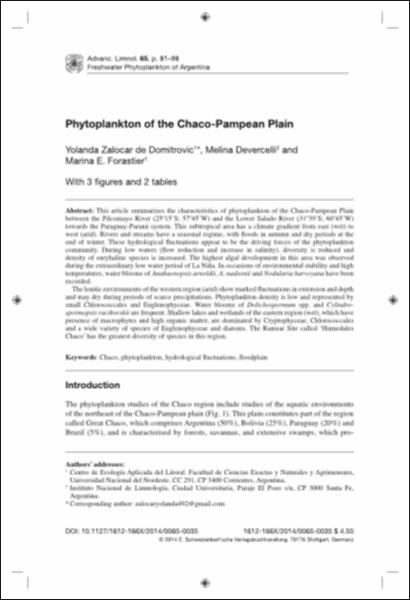Mostrar el registro sencillo del ítem
Phytoplankton of the Chaco-pampean plain
| dc.contributor.author | Zalocar de Domitrovic, Yolanda | |
| dc.contributor.author | Devercelli, Melina | |
| dc.contributor.author | Forastier, Marina Elizabet | |
| dc.date.accessioned | 2021-12-04T15:39:17Z | |
| dc.date.available | 2021-12-04T15:39:17Z | |
| dc.date.issued | 2014 | |
| dc.identifier.citation | Zalocar de Domitrovic, Yolanda, Devercelli, Melina y Forastier, Marina Elizabet, 2014. Phytoplankton of the Chaco-pampean plain. Fundamental And Applied Limnology. Stuttgart: E. Schweizerbartsche Verlags, vol. 65, p .81-98. ISSN 1612-166X. | es |
| dc.identifier.uri | http://repositorio.unne.edu.ar/handle/123456789/30285 | |
| dc.description.abstract | This article summarizes the characteristics of phytoplankton of the Chaco-Pampean Plain between the Pilcomayo River (25º15’S; 57º45’W) and the Lower Salado River (31º39’S; 60º45’W) towards the Paraguay-Paraná system. This subtropical area has a climate gradient from east (wet) to west (arid). Rivers and streams have a seasonal regime, with fl oods in autumn and dry periods at the end of winter. These hydrological fl uctuations appear to be the driving forces of the phytoplankton community. During low waters (fl ow reduction and increase in salinity), diversity is reduced and density of euryhaline species is increased. The highest algal development in this area was observed during the extraordinary low water period of La Niña. In occasions of environmental stability and high temperatures, water blooms of Anabaenopsis arnoldii, A. nadsonii and Nodularia harveyana have been recorded. The lenitic environments of the western region (arid) show marked fl uctuations in extension and depth and may dry during periods of scarce precipitations. Phytoplankton density is low and represented by small Chlorococcales and Euglenophyceae. Water blooms of Dolichospermum spp. and Cylindro spermopsis raciborskii are frequent. Shallow lakes and wetlands of the eastern region (wet), which have presence of macrophytes and high organic matter, are dominated by Cryptophyceae, Chlorococcales and a wide variety of species of Euglenophyceae and diatoms. The Ramsar Site called ‘Humedales Chaco’ has the greatest diversity of species in this region. | es |
| dc.format | application/pdf | es |
| dc.language.iso | eng | es |
| dc.publisher | E Schweizerbartsche Verlags | es |
| dc.rights | openAccess | es |
| dc.rights.uri | http://creativecommons.org/licenses/by-nc-nd/2.5/ar/ | es |
| dc.source | Fundamental And Applied Limnology, 2014, vol. 65, p .81-98. | es |
| dc.subject | Chaco (Argentina) | es |
| dc.subject | Phytoplankton | es |
| dc.subject | Hydrological fl uctuations | es |
| dc.title | Phytoplankton of the Chaco-pampean plain | es |
| dc.type | Artículo | es |
| unne.affiliation | Fil: Zalocar de Domitrovic, Yolanda. Universidad Nacional del Nordeste. Facultad de Ciencias Exactas y Naturales y Agrimensura; Argentina. | es |
| unne.affiliation | Fil: Zalocar de Domitrovic, Yolanda. Consejo Nacional de Investigaciones Científicas y Técnicas. Centro de Ecología Aplicada del Litoral; Argentina. | es |
| unne.affiliation | Fil: Devercelli, Melina. Consejo Nacional de Investigaciones Científicas y Técnicas. Instituto Nacional de Limnología; Argentina. | es |
| unne.affiliation | Fil: Forastier, Marina Elizabet. Universidad Nacional del Nordeste. Facultad de Ciencias Exactas y Naturales y Agrimensura; Argentina. | es |
| unne.affiliation | Fil: Forastier, Marina Elizabet. Consejo Nacional de Investigaciones Científicas y Técnicas. Centro de Ecología Aplicada del Litoral; Argentina. | es |
| unne.journal.pais | Alemania | es |
| unne.journal.ciudad | Stuttgart | es |
| unne.ISSN-e | 1612-166X | es |
Ficheros en el ítem
Este ítem aparece en la(s) siguiente(s) colección(ones)
-
Artículos de revista [671]





